

 |
||||||||||||||||
|
||||||||||||||||
I have tested and used many the Endurance and Endurance ED binoculars and spotting scopes from Hawk Sport Optics over the years. In terms of the scopes this goes as far back as 2014; when I first managed to get my hands on and test the large 85mm Hawke Endurance ED spotting scope, it impressed me so much it went on to win the BBR award for Best Overall Scope of 2014. Then a couple of years later, I reviewed the ultra-compact 50mm Hawke Endurance spotting scope which also went onto win a BBR award, this time for Best Compact/Travel Scope 2016/17.
My point is that I have a lot of history and experience with this brand and especially this series and in general my experiences with the Endurance series has pretty much always been a very positive one and thus when Hawke reached out me recently to ask if I wanted to test their new, updated 60mm version of the Endurance ED spotting scope, I, of course, jumped at the opportunity as I was interested to see if and how they have managed to continue developing and improving on what already was an excellent scope:
Checking on their website, Hawke currently produces the Endurance ED scope in four different configurations. The largest is an 85mm scope that comes with a 25-75x variable magnification eyepiece. Then there is a "standard-sized" 68mm version with a 16-48x magnification range. Then there are the two compact models, this 15-45x60 version and the tiny 50mm travel scope with an included zoom eyepiece with a range of 13-39x.
The two larger models and especially the 85mm Endurance ED will be for those who want the best performance possible and are prepared to carry about more weight and bulk. Whilst the tiny 50mm version will be suited to travelers, hikers, or anyone wanting a very small lightweight scope, but obviously at the cost of image brightness, low light performance, and power.
Whilst still considered compact, I had a feeling this 60mm spotting scope would fill the gap in between and make a good all-round option that you could still take on some travel adventures, whilst at the same time still offer plenty of reach, deliver bright, high-quality views, even in very low light and hopefully be reasonably good for digiscoping and thus it was the one that I decided would most like to test and review:
Contents:
The video above is of me unboxing the Hawke Endurance ED 15-45x60 Spotting Scope and going over my first impressions on it on the BBR YouTube channel.. completely unfiltered and unscripted! So sorry for rambling on a bit but I do think it gives you a good oversight as to what you can expect from the packaging, accessories, the general shape and appearance of the scope as well as some of the main highlights.
Main Shape
Like all Hawke Endurance Scopes, this has an angled body design with the eyepiece set at 45° and apart from it being a whole lot smaller, from first glance it looks very much like your typical full-sized scope, however, there are a few minor differences:
Firstly, if you look more closely you will notice that the eyepiece is positioned slightly off-center whereas most larger models will have the eyepiece placed right in line with the center of the barrel.
I assume with the very compact body, this is in order to accommodate the natural pathway of the light as it passes through the prisms, in any case, it is not a large amount and I didn't find that it hindered my aiming in the slightest. Indeed you really don't notice it at all.
There are a few other small differences (like the lack of a collar) which I will cover a little later in this review.
Chassis
Hawke Sport Optics makes no mention as to the materials used in the construction of the main chassis, but as an educated guess, I would say that it is most probably a combination of aluminum/magnesium and polycarbonate.
Whatever the case, the scope itself feels both solid and robust without being too heavy and is certainly light-years apart from the cheap and rather nasty all-plastic scopes that I have tested and reviewed in the past.
Exterior Armor
Whilst at first glance, it looks like the whole body and barrel has a rubber armor covering, much of it is left expose and is only painted and it is only the black region below the eyepiece and around the foot that is actually rubber.
This design certainly looks nice but perhaps does not offer as much protection as a fully rubber-coated scope. Whilst it is finished off in a matte green color which helps, this smoother, harder surface is also a little more reflective than that of most rubber, which for those who need to be as stealthy as possible may be a consideration.
However, if it is, you could always leave the stay-on cover on the scope which will eliminate this issue.
Fog & Waterproof
The main housing on this and indeed all Hawke Endurance spotting scopes are waterproof and filled with nitrogen.
Purging the inside of the barrel of air which contains moisture and replacing it with a dry gas like nitrogen prevents the internal lens surfaces from fogging or misting up which can and does occur on unsealed scopes, especially when you get a rapid temperature change, like stepping out your warm house on an early winter morning.
Having a fully sealed instrument also prevents dust from entering in dry conditions and an unsealed scope is for me a definite indicator of a poor quality one.
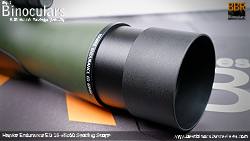 Sunshield
Sunshield
Whilst they are very common on better quality full-sized and large instruments, I have noticed that compact/travel scopes will quite often not have an extendable sunshield on the body which I feel is a mistake as not only do they help prevent lens flare in some light conditions, but they also help protect the lens from gathering dust or shield it from the rain in wet conditions.
So I was happy to see that Hawke has still decided to keep it on this new 60mm Endurance ED.
The shade itself is made from hard plastic and slides with a good level of friction over the barrel below. This is good and many sound trivial, but it means that it does not slip back too easily which is something that can get very annoying if you often point the end of the barrel skyward!
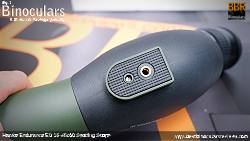 Mounting
Mounting
As you would expect, attaching the scope onto a tripod is very straight forward. Depending on the setup of your tripod, you simply screw your tripod head/or the plate on your tripod head into the threaded recess on the scope's foot.
Measuring just 3cm wide and 5cm long, the foot/mounting plate on the Hawke Endurance ED 15-45x60 Spotting Scope is relatively small for a spotting scope, but for such a small instrument, I found it to be perfectly adequate and never had an issue with movement or slipping even when adding extra weight whilst digiscoping.
The fact that the base has a textured rubber sole certainly helps with this as does fact that it has the small recess just in front of the main thread which designed to accept the spring-loaded nipple on your tripod head or plate (if it has one) also really helps and for me is another indicator to the good attention to small details that Hawke show in this scope.
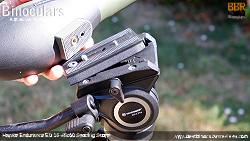 I also like the fact that the main thread is made from brass and not plastic which is sometimes the case on lesser quality instruments.
I also like the fact that the main thread is made from brass and not plastic which is sometimes the case on lesser quality instruments.
No Collar
One aspect where these smaller Hawke Endurance scopes differ from the larger versions is that they lack a collar.
The foot on many scopes does not fix directly to the body as is the case on this one. Rather it forms part of a collar that wraps around the barrel which can be loosened allowing the scope to rotate around the foot.
Able to rotate the eyepiece relative to the foot can be useful in some situations like on uneven ground for example or when placing the scope next to you at a shooting or archery range so you can more easily look through it just by turning your head to one side.
So this may be a little bit of a shame to some users but could be as a result of Hawke trying to keep the size and weight of this scope to a minimum. Although, there are certainly compact scopes out there that do come with a collar, for example, the Opticron MM3 60 GA ED Travelscope.
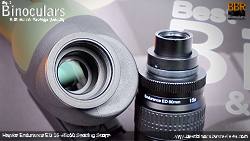 Unlike cheaper, usually less well-made instruments, the eyepieces on the whole range of Hawke Endurance ED Spotting Scopes are not permanently fixed to the body, rather they can be unscrewed and remove and replaced with another eyepiece should you wish.
Unlike cheaper, usually less well-made instruments, the eyepieces on the whole range of Hawke Endurance ED Spotting Scopes are not permanently fixed to the body, rather they can be unscrewed and remove and replaced with another eyepiece should you wish.
This can be useful for some specific applications where you may want a fixed magnification with a very wide field of view or perhaps very high power.
Indeed it is important to keep in mind here that some of the very top-end scopes like those from Zeiss, Swarovski, and Kowa don't automatically come with an eyepiece included (unless you buy it as part of a bundle) and they need to be purchased separately depending on your needs.
Hawke however does supply an eyepiece with the scope and to ensure that it is useful in a wider range of applications as possible the one they have chosen has a variable magnification/zoom eyepiece with a wide range of 15x up to 45x.
Attachment
A few scopes that I have come across use a bayonet system, but the eyepiece on this scope uses what is in my experience a more popular threaded collar, with the eyepiece having the male thread.
I managed to find out from Hawke that the eyeoiece uses the M37x0.75-6H thread on this 60mm, which is the same as that used on their 85mm Endurance scope. I think this is fairly common as I was also able to swap out the eyepiece on this scope and replace it with the one that came with the Bresser Pirsch Gen II 20-60x80 Spotting Scope that I have recently reviewed and still happened to have with me.
Magnification/Zoom Adjustment
To adjust the magnification on this zoom eyepiece you simply turn the rubber track on the eyepiece in either direction.
I like the fact that the track is nice and wide and thus easy to quickly locate when not looking and/or when wearing thick gloves in winter and whilst reasonably tight, the mechanism was nice and smooth and without any free play or rough sections anywhere along the entire range.
Eye-Cup
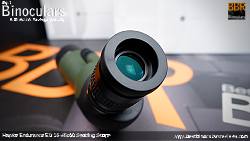 The included eyepiece comes with a twist-up eyecup that is designed to make it easy to keep your eye at the correct distance (eye-relief) behind the ocular lens and thus be able to observe the entire image without black rings on the edges of the view.
The included eyepiece comes with a twist-up eyecup that is designed to make it easy to keep your eye at the correct distance (eye-relief) behind the ocular lens and thus be able to observe the entire image without black rings on the edges of the view.
Most twist-up eyecups have predefined click stops in-between the maximum and minimum settings, however, in this case, Hawke has opted to forgo these and rather rely on there being enough resistance in order for you to position the eyecup at any point and have it remain there.
I found this to work perfectly fine when testing my sample and the cup would only twist inwards if I really put a lot of force against it which was far more than what I would normally use when placing my eye against the cup.
For most users, the eyecup will be fully extended and then if you wear glasses, probably have it fully retracted anyway.
Focus Wheels & Focusing
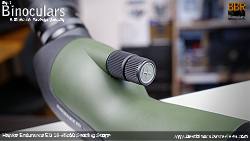 As with the larger models in this series, the Hawke Endurance ED 15-45x60 Spotting Scope has a dual-speed focusing mechanism which just like the others I have used is excellent:
As with the larger models in this series, the Hawke Endurance ED 15-45x60 Spotting Scope has a dual-speed focusing mechanism which just like the others I have used is excellent:
Firstly I have to highlight that the actual mechanism on both of the focus knobs on my sample was extremely smooth, there were no rough sections or any amount of free play anywhere along the entire focusing plane and the fine focus knob, in particular, had an extremely light action meaning that you only needed to lightly brush it to make minute changes and zero in the focus to get it 100% sharp.
The slightly larger knob nearest the eyepiece uses a higher gear ratio and thus is designed so that you can make large focus adjustments more quickly and get near to where you want to be and then you just move your finger onto the smaller knob in front of it that has a much lower gear ratio and thus enables you to more easily fine-tune the focus.
The large knob takes about 5.5 turns to go from one end to the other (so minimum focus to infinite), which in my experience is still a pretty low gear (I have has some that take just over 3 turns) and so perhaps not as swift to make large changes as some.
Body Construction Quality: 8/10
Weight
As is clearly illustrated in the table below, at 31.6ozs / 895g (without accessories) this Hawke Endurance ED is on the heavier side for a 60mm spotter but having said that the difference in most cases is very minor. It is also important to keep in mind that whilst being lightweight is an important feature to look for when choosing a travel scope, very lightweight ones often use many plastic parts which is most certainly not the case with this Hawke.
I think here what is more important to note is how much more lightweight all the 60mm scopes are when compared to full-sized 80-90mm ones:
Dimensions
In terms of its length, this Hawke Endurance ED 15-45x60 Spotting Scope compares well against other 60mm scopes, and once again here I think it is more important to see how they compare to the larger 80-90mm scopes as well as the smaller 50mm ones.
Just keep in mind that whilst larger and heavier, the larger lenses on full-sized scopes will most certainly result in a brighter image (especially in low light) than an equal quality one with a smaller lens and this is an important decision to make when deciding what size of scope is best for your particular needs.
Body Stats Score (60mm): 8/10
As with the whole range of Hawke Endurance ED binoculars, many of which I have tested and reviewed, all the Endurance ED scopes really excel when it comes to the level of optics and coatings at this price level and this is for me the main area where I feel you are getting exceptional value for money with this scope:
Hawke Sport Optics does not go into specifics in regards to the exact makeup of the elements that form the main objective lens on this Endurance ED Spotting scope, but there are two things that we know for sure:
Firstly the outer element has a diameter of 60mm and then secondly at least one of the elements is made from ED (Extra-Low Dispersion) glass.
All good quality scopes will use low dispersion optical glass in their lenses to ensure that the wavelengths of light are controlled to a much greater degree than standard glass, but the particular properties of ED glass give the makers of the lens even more options to better control each of the different wavelengths and thus if designed well, it will potentially enable a sharper, higher resolution image by reducing chromatic aberrations and thus show less color fringing.
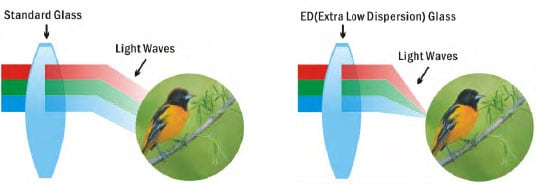
The emphasis here is ED glass gives the potential for improved image quality, but simply using it does not guarantee it:
I have often looked through high-quality, well made non-ED glass binoculars and scopes and seen a better image than that produced on a poor quality ED ones.
To see just how well Hawke has done in this regard, take a look at the Image Quality Section below.
I measured the outer lens on the included eyepiece that comes with this Hawke Endurance ED 15-45x60 Spotting Scope to have a diameter of 23mm in diameter, which is nice and large.
Larger ocular lenses can offer a number of potential advantages including helping produce a wider field of view and a higher image resolution, but what is most certain is that they make it that much easier to line your eyes up with them and thus see the full image without black rings on the edges.
Whilst not quite as compact and travel friendly as your average 50mm scope, the 60mm objective lens on this Hawke Endurance ED Spotting Scope and other scopes in this size category do offer a number of advantages over them, yet at the same time are still what I would consider to be a small scope, especially when compared to 80mm and 90mm ones and thus I feel offer a good compromise between the two extremes:
Mathematically, at 15x magnification, you get a 4mm exit pupil (60÷15), which is exactly the same as an 80mm scope with a 20x magnification, and close to a 50mm scope with a minimum 12x or 13x magnification which are also popular choices.
Once you have fully zoomed in at 45x power, this 60mm scope delivers a 1.33mm exit pupil (60÷45), which is certainly not great for low light uses, but once again, it is exactly the same size as the exit pupil you get at the maximum power (60x) of many 80mm scopes (80÷60) and similar to a 50mm scope at 36x.
Obviously, large scopes are able to gather more light, and thus assuming all else is equal they will most probably perform better, especially in low light conditions, but even so, at lower magnifications, this scope should offer a reasonably good performance in fairly low light situations.
At the higher magnification levels, you do get much more image detail, but you also notice that the image gets much less bright, especially in poorer light conditions.
For normal use, this is important to keep in mind, but when digiscoping this is even more important as your camera receives much less light to work with and a smaller exit pupil is much harder to line up with and thus it can often be quite difficult to capture footage without black rings on the edges. For more: complete guide to the exit pupil.
Unlike the Hawke Endurance ED binoculars that exclusively use Roof prisms, the angled Hawke Endurance ED Scopes are advertised as using BAK-4 Porro prisms inside of them to correct the inverted image.
What is great about this is, like for like, a Porro prism is more efficient and reflects 100% of the light that enters it and thus does not require expensive mirror coatings to perform at the highest levels.
On top of this Porro prisms do not cause the individual wavelengths of light to step out of phase with each other and so once again, unlike Roof prisms, they do not need special phase correction coatings to deliver the highest definition images.
However, whilst researching this scope for the review, I also noticed that Hawk describes their prisms in the scope as being "Dielectric Coated for increased reflectivity".
As far as mirror coatings go on prisms, Dielectric ones are the best and because of the expertise needed and the price, are usually only found on higher-end Roof prism instruments! So at first, this did not make sense to me because as we have discussed, Porro prisms do not require any mirror coatings.
However, if you take a look at the cutaway diagram above, you will notice the Porro prisms behind the focusing lens and under the focus wheels (labeled 3), but then there is another prism that re-directs the light at the 45-degree angle needed for an angled spotting scope. I believe it is this prism that requires the mirror coatings to ensure as much light gets to your eyes as possible and so this is where I think Hawke uses the very best Dielectric coatings.
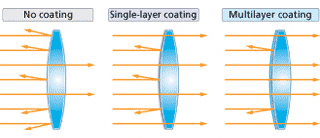 Anti-Reflection Coatings
Anti-Reflection Coatings
Whilst I would not expect anything less at this quality level and price range, it is important to point out that just like the binoculars in this series, the optics on the Hawke Endurance ED spotting scopes are "Fully Multi-Coated", which is exactly the wording we want to read.
Some lesser, usually cheap scopes will only be "Multi-Coated", which means that only some of the lens surfaces are treated with anti-reflection coatings as opposed to all of them (usually the first and last).
The difference this makes in terms of image brightness and quality is certainly noticeable and for me is one of the most important things to look for when comparing many optical devices.
Optical Components Quality Rating: 9/10
Field Of View (FOV)
Unlike a fixed magnification eyepiece that has a fixed field of view, the width (and height) of your view changes depending on what magnification you have set your variable magnification eyepiece to.
So the more zoomed in you are, the narrower the field of view:
Thus at 15x power, you get a view that is 49 meters wide when measured at a distance of 1000 meters (147ft @1000yds).
Then as you zoom in this decreases until at the maximum 45x power it is now only 26m (78ft) feet wide at the same distance.
This field of view can also be represented at an angle from the scope (or binocular), sometimes referred to the angle of view on this Hawke Endurance ED 15-45x60 Spotting Scope it starts at 2.8° at 15x and reduces down to 1.5° at 45x magnification.
A wide view makes it much easier to locate and then follow objects when looking through the scope, this is why for small fast-moving things like birds, I find the best way to lock onto them is to first set the magnification to 15x and then once you have it in your view and not moving, you then zoom in to the higher powers.
So how well does this Hawke Endurance ED 15-45x60 Spotting Scope compare with others, well if we take a look at the table below, you will see that they do very well and almost match that of the Celestron LandScout that has a substantially lower minimum 12x power, which I think is impressive:
Minimum Focus Distance
When it comes to spotting scopes that are primarily designed to look at things in the distance, for many, the close focus distance may be of little or no importance, but if like me, you also like to not only observe things like butterflies on nearby flowers, but also take images and video of them by digiscoping, then having a good minimum focusing distance is important.
With the included eyepiece, this Hawke Endurance ED 15-45x60 Spotting Scope has an advertised close focus distance of 2.5m / 8.2ft, which I found to be correct when I tested it.
This minimum close focus distance is truly excellent and indeed matches that of the smaller, less powerful Hawke Endurance 12-36x50mm Scope.
Eye-Relief:
Just like the field of view and to a lesser extent, the minimum focus distance, the ideal distance your eye needs to be behind the ocular lens (eye-relief) changes as you adjust the magnification.
Unfortunately, Hawke only gives us one measurement that is 20mm (0.8"), which is excellent, but I would assume this is the best-case scenario when at 15x power.
I am not sure what the eye-relief reduces down to at 45x magnification, but I did test the scope and eyepiece whilst wearing my glasses and found that at 15x it was very easy to achieve the full image without any black rings forming on the edge of the view with the eyecup fully twisted down. In fact, I could have it positioned at about halfway and it would still be fine for me, my thickness of glasses, and my shape of face.
At full 45x power, it was still just possible for me to achieve the full image with the eyecup fully twisted down and thus I would recommend this as being a good choice for the eye-glass wearer. Be that sunglasses, to correct vision, or for eye protection like you often would use at a target/shooting range.
Optical Stats Score (12x-45x Eyepieces): 9/10
Describing and indeed rating the image I see its quality is, without doubt, the hardest part of every binocular and spotting scope review that I write.
Why Not Just Use Photos & Video?
I often get asked why don't I just take photos through the binocular or the scope and just use them instead of words.
Whilst I do include some digiscoping photos and videos on some of my reviews, this is only for me to test how the instrument performs for digiscoping and I do not suggest that you use them to judge as to the quality of the view as what I see is usually far, far better than what I am able to achieve when taking a photo!
Apart from my obvious lack of skill as a digiscoper, the other problems include the fact that the camera I use may change, and thus so does the quality.
Also, some scopes and binoculars are just harder to take images through, and thus the results are never as good as those that are easier to digiscope with, but this does not mean that the image you see with your eyes is any worse.
Finally just keep in mind that in order to publish a photo or video on the web you will need to do some sort of processing, at the bare minimum this involves making the file size smaller, which will reduce the quality, but also could involve color grading, etc, which will obviously mean that it deviates from the original.
So if I do use digiscoping images and video for any reviews, I would look at them in just this context and not as a guide to image quality overall.
Benchmarks
Usually, I will use a benchmark in the same size and magnification category that I use for all reviews in the same class to help me to be as consistent as possible.
I currently don't have a benchmark scope in this category and so for this review, I used my mid-level benchmark 80mm spotting scope that has a 20-60x zoom eyepiece fitted.
Whilst not ideal, I still think the results are interesting, especially if you are undecided as to whether you should be going for a standard-sized 80mm scope or a more compact, travel-friendly 60mm scope like this Hawke Endurance ED.
Anyway I carried out these comparison tests twice: once in normal/good light conditions during the day (it was slightly overcast) and then again that evening as the sun was setting and then went below the horizon and below are my thoughts and findings:
Color Reproduction, Vibrancy & Contrast
In terms of the colors and how they appear when looking through the scope, I would say that to my eyes they appear true to life and that I never noticed any sort of tinting to the image.
Just like when you look about without the scope, the vibrancy of these colors and the level of contrast that you see is closely related to how much light is available.
Thus you do get a slightly different perspective when using a scope on a dull and gloomy day when compared to a bright sunny day.
Viewing objects at higher magnifications can also throw you a bit though as you get a much shorter depth of view, and thus if you focus on something like a flower or a bird, it can seem to really "pop out" from the background and truly look spectacular. This is a good thing and certainly something that I really appreciate when looking through a scope, but it can make it hard to judge!
On top of this the image quality and brightness certainly changes as you adjust the magnification - this is largely down to the size of the exit pupil getting smaller as you zoom in.
But in general, I would describe the image you see through this Hawke Endurance ED 15-45x60 Spotting Scope as beige both vibrant and with a good level of contrast. But not so much so as to look unreal.
Image Brightness
When looking through this or indeed any scope, just how bright I perceive the image to be is a result of many factors that include the amount of available ambient light, the size of the objective lens, the quality of the optics used and their coatings and what magnification you are using.
In good and even average light on an overcast day, I would sum up the image I observed through the Hawke Endurance ED 15-45x60 Spotting Scope as being as bright as I had hoped for and at times I really could not notice the difference between this and my larger 80mm benchmark scope, this was especially true if I matched the magnifications between the two.
In low and especially very light, I could more easily notice that the large scope performed a little better.
This difference between the two was more obvious when using the same magnification as then not only did the larger scope have a bigger lens with which to collect light, but so was the exit pupil and in these poor light conditions, the pupils were sure to be bigger and thus this was certainly a limiting factor.
However, overall I would rate the image brightness on the Hawke Endurance ED 15-45x60 Spotting Scope and included zoom eyepiece as being very good and am sure it ranks up there with the top instruments in this size class.
Color Fringing
As I mentioned at the start of the optics section, the fact that these Hawke Endurance ED spotting scopes use Extra-Low Dispersion (ED) glass they have the potential to better reduce the amount chromatic aberrations, which are what causes the color fringing you see around the edges of highly contrasting images in the view. So how well did it actually do?
Well, I performed my usual test of looking along the edge of the black telephone wire that runs past my house against a bright blue sky and boy was I impressed.
At 15x you could really not notice any, and whilst color fringing most certainly becomes more obvious at higher magnifications, even at full 45x power, I thought that this scope performed extremely well in this area.
Now I know that earlier I said that I don't use photos when describing the quality of the view, but whilst digiscoping with this scope, I also decided to take some footage of the telephone wire that I used for the color fringing test and I do believe that it accurately depicts the amount that I observed when looking through it at 15x magnification, so I have decided to include it to give you an idea:
As I say, in my experience these levels are perfectly normal for a scope at this level at high magnification, I just showed them to demonstrate what I was referring to for those who have not seen it before.
Image Flatness
During all my tests and indeed just generally using the scope I never once noticed any sort of curvature distortions and when focused on an object at the center of the view, it remains sharp all the way to the edges.
On a scope at high power, this is especially important otherwise you have to keep adjusting the focus or move the view about when carefully studying an object carefully.
Softening
Another very impressive aspect of the image is just how little softening or vignetting that there is right at the edges of the view when you are looking through Hawke Endurance ED 15-45x60 Spotting Scope. As with just about all the other areas mentioned above, in this regard, they certainly compare very favorably against their direct competition.
Image Quality Rating (for a 50-60mm Scope): 9/10
The extra goodies that come with the Endurance ED are petty much what I would usually expect to find included with a spotting scope:
The main design and look of the protective stay-on cover is very typical and looks very much like most others I come across, but in terms of quality, it is certainly one of the better ones out there:
The outer material that is used looks smart and feels like it should last and on my sample, the stitching along all the seams was excellent, and whilst for the most part it is pretty generic, I do like the fact that Hawk has added their logo to the flap that covers the focusing barrels.
In terms of the padding it is reasonably thin and whilst more padding would certainly add protection, it would also make the cover more bulky and cumbersome, so for me this level is about right.
As with the material, the main zipper that tightens the cover around the scope looks to be of good quality and reasonably robust. The actual fit of the cover is just about right in that it is tight enough so as to not slide or flop about on the scope, yet not too tight so as to make it hard to take on and off.
The cover has a cutout that exposed the foot, so you can mount the scope with the cover on and then there are a number of other tethered flaps and mini covers held in place with strips of Velcro so that you can either have it so that it fully covers the entire scope, or reveal the objective lens, eyepiece, and focus wheels and so can be used almost normally.
The cover has a strap/sling with a small slideable shoulder pad. The strap attaches to the cover at two points via a couple of swiveled quick release clips and so can be completely removed should you wish.
Hawke also includes a number of soft rubber/plastic covers to protect the lenses when not in use:
The good part is that they all fit nicely and so are no problem to replace and remove, but at the same time are unlikely to come away by accident.
The objective cover is also tethered to the scope via a separate ring that goes around the barrel.
So whilst the all works perfectly fine, for a scope at this level, I think it would have been nicer if the objective lens cover in particular was less generic, perhaps fitted into the end of the barrel and made of just of a little higher quality, more robust material as I do wonder if the connection between the cover and the tether will stand the test of time, especially at the fold.
As well as the main eyecup and objective lens cover, the eyepiece also comes with its own soft rubber covers, one that fits over the end of the eye-cup and then another that you use to cover the other end should you unscrew the eye-piece from the body.
Cleaning Cloth
The Hawke Endurance ED 15-45x60 Spotting Scope is also supplied with a cleaning cloth that I would say is fine for cleaning the body and perhaps light use on the lenses when out in the field.
But as always I would encourage you to obtain a Lens Cleaning Kit. for properly cleaning the lenses, I most certainly. These don't necessarily need to be expensive, but used in the right way will allow you to properly clean the lenses without the risk of damaging the coatings.
Manual
Hawke Sport Optics includes an extremely basic instruction manual. Written in a number of languages it includes very brief information on how to set up the scope, the controls, and cleaning.
Warranty
Note whilst the Hawke Endurance ED 15-45x60 Spotting Scope is covered by a lifetime warranty, the eyepiece has a separate 2year warranty. Also note that in the UK and Europe the warranty is restricted to 10 years.
Extras Rating: 7/10
I'd like to start this section by stressing that I am far from being an expert when it comes to digiscoping as well as this, in order to get truly great photos and videos (especially of nature/wildlife) takes a lot of time, which I don't always have when testing a scope and thus the results that I am able to achieve should be looked at as the baseline or the bare minimum.
Nonetheless, because I try to digiscope with just about every scope that I review, I do feel my thoughts and opinions as to how easy it is or how good the particular scope is for digiscoping is useful as there is no doubt some are simply better for it than others. Also, as I stressed in the Image Quality section above, you should not look at these digiscoped photos a being representative of the image that you actually see when looking through the scope; What I see is way better than what I am personally able to capture when using either my phone or camera through the eyepiece of the scope.
So having said that, the eyepiece on this Hawke Endurance Spotting Scope is pretty standard in its design and thus it was very simple for me to attach the Snypex X-Wing SPA1 Universal Smart Phone Adapter that I used for testing and would say that most good universal digiscoping adapters will be fine.
In my experience when it comes to digiscoping you need to play around a bit before you get it right and this certainly depends on the type of camera or phone that you will be using. This time as you can see from my samples I did struggle to get the complete field of view when using my phone. In fact, I had much better success by just hand holding my main camera up to the eyepiece which is what I used to take the main cropped in the image of the pink flowers below.
As always, I found it much easier to capture good video than photographs. It was windy whilst I was testing and the problem I had was that the flowers were blowing about quite a bit and thus even with a tripod and a fast shutter speed I struggled to get a sharp photo. I do plan to publish some of the video footage that I managed to capture. When I do, I will add it to this review.
I took the photo above by hand holding my Fujifilm X-T200 up to the eyepiece which was set to 15x magnification - Note the photo is also cropped and sharpened as I just wanted to show what was possible to achieve with this scope by a very average digiscoper!
The two photos above are both screen grabs that I took from the video footage that I captured using my phone. These actually turned out to be of better quality than the photographs. This was mainly because it was a windy day and with all the movement of the flowers, I just could not get a sharp image.
When it comes to digiscoping with a zoom eyepiece, I find that it is much easier and I get better results when I keep the magnification down, in fact, all the half-decent footage that I managed to capture with this Hawke Endurance ED 60 Spotting Scope was at the minimum 15x power.
This is largely down to the size of the exit pupil because at lower powers it is large and thus it is easier to line your camera up with it and just as with your eyes, the camera receives more light with which to work with.
When using the scope normally, you could easily use a monopod, but when digiscoping a tripod is absolutely essential. During all my testing, I used the Bresser BX-5 Pro tripod with it's video pan and ball head that has instantly become a firm favorite of mine and would highly recommend. Although it may be a little overkill for such a small scope, so you could get away with a smaller head especially.
Ideal Uses Include:
Hawke Endurance ED 15-45x60 Spotting Scope
As I pretty much expected expected from my past dealings with both Hawke Endurance ED scopes and binoculars, the overall feel, general build and image quality on this scope is truly excellent at this price level:
Reviewed by Jason Whitehead for Best Binocular Reviews
|
Main Specifications & Features:

Full-Size Spotting Scopes | Compact/Travel Spotting Scopes
Compact Binoculars | Porro Prism Binoculars | Stabilization Binoculars | General Use Binoculars | Safari Binoculars | Birdwatching Binoculars | Top of the Range/High Value BinocularsBelow is a similar Spotting Scope that you may also want to have a look at:
Compact scope with very high quality optics for a stunning image, perfect for travel, safaris, birdwatching, hunting or wherever you need...
General Price Range: (5/6) High Value Spotting Scope
Below is a link that will take you to a page with online retailers in both the US and UK that sell Hawke 15-45x60 Endurance ED Spotting Scope this page makes it easy to compare prices and then to buy from your preferred option:
|
Buy & Compare Prices for the Hawke 15-45x60 Endurance ED Spotting Scope |
||
US Shoppers |
Canadian Shoppers |
UK Shoppers |
Deutsch Shoppers |
Aussie Shoppers |
Indian Shoppers |